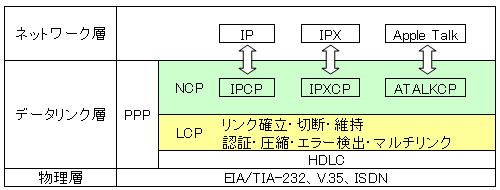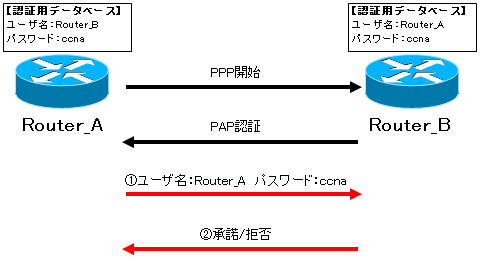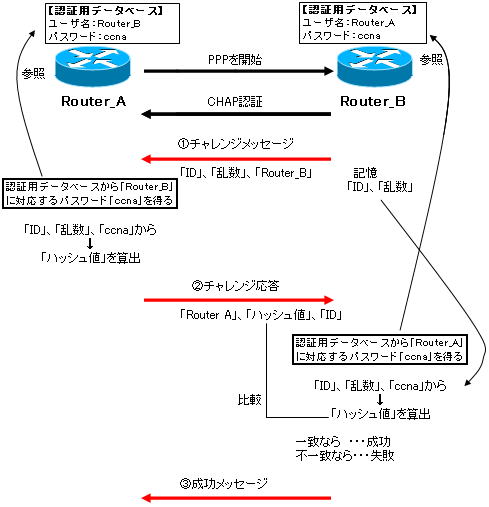PPPとは
PPPは、IOS DHLCをベースにしているデータリンク層のプロトコルでWANで使用されている最も身近なプロトコルです。認証や、圧縮など豊富なオプションから、ダイヤルアップ、専用線、DSL、FTTHなどで使用されています。
PPPは、ポイントツーポイント接続する際に使用します。
また、PPPは、マルチプロトコル環境をサポートします。ネットワーク層にIPを使用する場合は、IPCP、IPXを使用する場合は、IPXCP、Apple Talkを使用する場合は、ATALKCP(Apple Talk Control Protocol)を使用することでマルチプロトコル環境に対応しています。

PPPには、「LCP」と「NCP」という層があります。
LCP
LCPでは、リンクの確立、切断、維持を担当しています。
また、LCPのオプションでは、
・認証
・圧縮
・エラー検出
・マルチリンク
を設定します。
NCP
NCPでは、ネットワーク層のプロトコルとネゴシエーションを行います。IPCP、IPXCP、ATALKCPを使用することにより、マルチプロトコル環境に対応させています。

①リンク確立フェーズ
・LCPフレームを送信してデータリンクを設定、テストを行います。
・MTU、圧縮、リンク認証などについてネゴシエートします。
②認証フェーズ
・認証を使う場合、ネットワーク層プロトコル フェーズの前に開始されます。
※認証機能を利用しなくても良い。
③ネットワーク層プロトコル フェーズ
・NCPパケットを送信してネットワーク層のプロトコルを選択して設定を行います。
PPP(PAP)
PPPでは物理的なリンクが確立した後、ユーザ名とパスワードを送信して、接続を許可してもらうための認証を受けます。
認証方法として、PAPとCHAPを選択できますが、認証が必要なければ、認証の設定は省略できます。確認証の特徴は下の表の通りです。
| 認証方式 | 特徴 |
|---|---|
| PAP | ・クリアテキストでパスワードを交換する。 ・認証は、初めの1回のみ。 |
| CHAP | ・暗号化したパスワードを交換。 ・定期的に毎回違う文字列で認証を行う。 |
ここでは、PAPについて説明してゆきます。
PAPとは、Password Authentication Protocolの略で、ユーザ名とパスワードがクリアテキスト(平文)のまま送られます。クリアテキストで、ユーザ名とパスワードが回線上を流れると、簡単に第三者に盗聴されてしまう心配があります。
それでは、PAPは、セキュリティ上、好ましくないという理由で、CHAPが主に使われてきたかと言えば、そういう訳でもありません。家庭からプロバイダに接続する際には、PAPが多く使用されてきました。
と言うのも、パスワードがクリアテキストでで流れる区間は、電話線になるため、人目にさらされるインターネットより比較的安全だからです。
認証の流れは、次の図のように2ウェイハンドシェイクで行われます。

PPP(CHAP)
CHAPは、Challenge Handshake Authentication Protocolの略です。チャレンジ・レスポンス方式を用いて、回線上にパスワードそのものを流さないように工夫しています。
上の「PPP(PAP)」で、説明したように、PAPでは、回線上にユーザ名とパスワードがクリアテキストのまま、流れてしまいます。より、セキュリティを高めた認証を使いたい場合は、CHAPを選択します。CHAPによる認証は、ユーザ名とパスワードを基にした暗号化処理で認証が行われるので、PAPよりもセキュリティが高い認証を行うことが可能です。
認証の流れは、下図のように3ウェイハンドシェイクで行われます。

